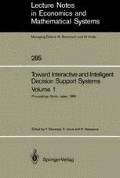Abstract
In this paper we discuss issues related to time path objectives and user control in the context of a specific multiple objective linear programming (MOLP) problem. The specific MOLP is a multi-time period manpower supply forecasting model that is set in a decision support systems environment. We describe the techniques used to model the multiple time path objectives and the need for user control over the parameterization of the model, the search for a final solution, and the way output is displayed. In the light of the pros and cons of the interactive Tchebycheff and reference point methods of multiple criteria optimization, the implications of our experiences are discussed with regard to future solution procedure design.
The opinions expressed in this paper are those of the authors and do not reflect the official views of the U. S. Navy Department.
The contributions of this author have been partly supported by ONR contract N00014-85-0555-04.
Access this chapter
Tax calculation will be finalised at checkout
Purchases are for personal use only
Preview
Unable to display preview. Download preview PDF.
References
Bres, E. S., D. Burns, A. Charnes, and W. W. Cooper, (1980). “A Goal Programming Model for Planning Officer Accessions,” Management Science 26(8), pp. 773–783.
Charnes, A., W. W. Cooper, and R. J. Niehaus, (1972). Studies in Manpower Planning, U.S. Navy Office of Civilian Manpower Management, Washington, D. C.
Fedra, K. and D. P. Loucks, (1985). “Interactive Computer Technology for Planning and Policy Modeling,” Water Resources Research, 21(2), pp. 114–122.
Grauer, M. (1983). “A Dynamic Interactive Decision Analysis and Support System (DIDASS): User’s Guide,” WP-83–60, International Institute for Applied Systems Analysis, Laxenburg, Austria.
Isermann, H. and R. E. Steuer (1985). “Payoff Tables and Minimum Criterion Values Over the Efficient Set,” College of Business Administration, University of Georgia, Athens, Georgia.
Lewandowski, A. and M. Grauer (1982). “The Reference Point Optimization Approach — Methods of Efficient Implementation,” In Grauer, M., A. Lewandowski, and A. P. Wierzbicki (eds.), Multiobjective and Stochastic Optimization, International Institute of Applied Systems Analysis, Laxenburg, Austria, pp. 353–376.
Price, W. L. and W. G. Piskor, (1972). “The Application of Goal Programming to Manpower Planning,” INFOR, 10(3), pp. 221–231.
Silverman, J., R. E. Steuer, and A. W. Whisman (1985). “Computer Graphics at the Multicriterion Computer/User Interface,” Lecture Notes in Economics and Mathematical Systems, No. 242, Berlin: Springer-Verlag, pp. 201–213.
Silverman, J., R. E. Steuer, and A. W. Whisman, (1986). “A Multi-Period, Multiple Criteria Optimization System for Manpower Planning,” European Journal of Operational Research, to appear.
Steuer, R. E. (1986). Multiple Criteria Optimization: Theory, Computation, and Application, New York: John Wiley & Sons.
Steuer, R. E. and E.-U. Choo, (1983). “An Interactive Weighted Tchebycheff Procedure for Multiple Objective Programming,” Mathematical Programming, 26(1), pp. 326–344.
Wierzbicki, A. P. (1980). “The Use of Reference Objectives in Multiobjective Optimization,” Lecture Notes in Ecomonics and Mathematical Systems, No. 177, Berlin: Springer-Verlag, pp. 468–486.
Wierzbicki, A. P. (1985). “On the Completeness and Constructiveness of Parametric Characterizations to Vector Optimization Problems,” Institute of Automatic Control, Technical University of Warsaw, Warsaw, Poland.
Author information
Authors and Affiliations
Editor information
Editors and Affiliations
Rights and permissions
Copyright information
© 1987 Springer-Verlag Berlin Heidelberg
About this paper
Cite this paper
Silverman, J., Steuer, R.E., Whisman, A.W. (1987). User Control and Multiple Time Path Objectives in a Manpower Planning Decision Support Systems Environment. In: Sawaragi, Y., Inoue, K., Nakayama, H. (eds) Toward Interactive and Intelligent Decision Support Systems. Lecture Notes in Economics and Mathematical Systems, vol 285. Springer, Berlin, Heidelberg. https://doi.org/10.1007/978-3-642-46607-6_13
Download citation
DOI: https://doi.org/10.1007/978-3-642-46607-6_13
Publisher Name: Springer, Berlin, Heidelberg
Print ISBN: 978-3-540-17718-0
Online ISBN: 978-3-642-46607-6
eBook Packages: Springer Book Archive

